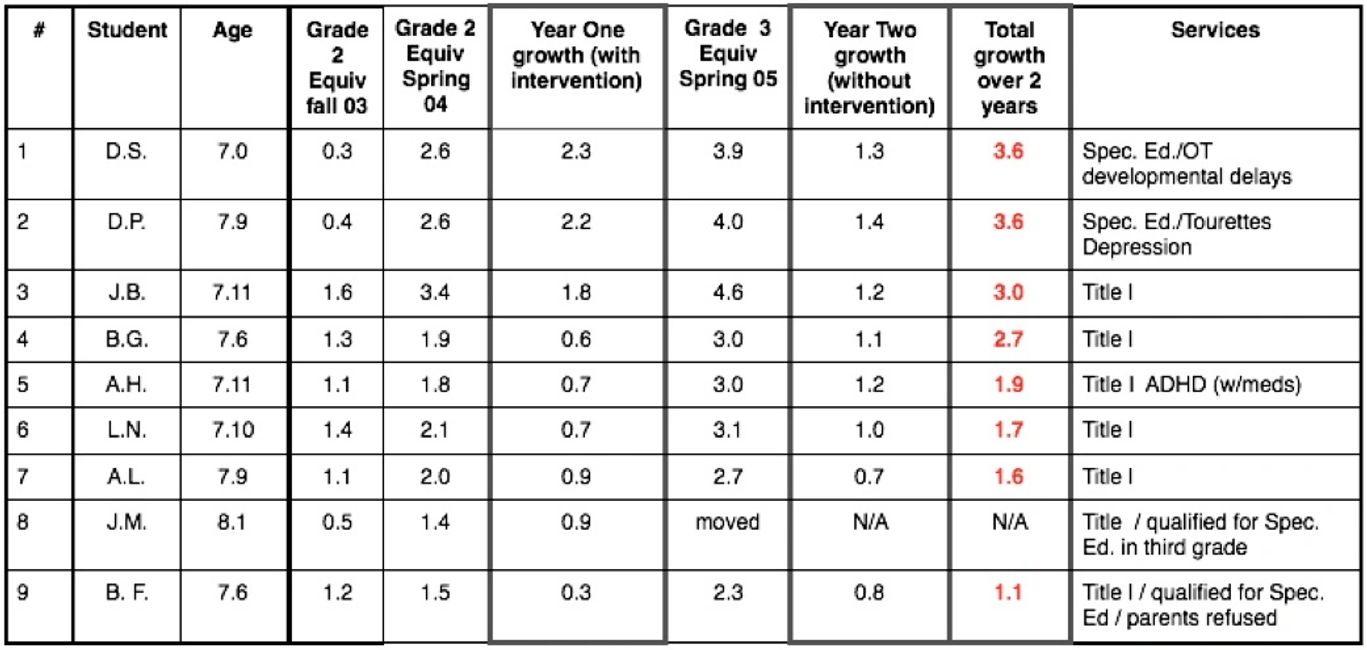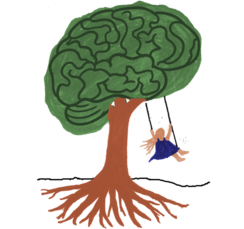My Data
In 2003 the administration asked me to teach a class of second and third grade students who were struggling academically. All students in the class had qualified to receive Special Education services or Title I services. It was my first opportunity to utilize the training I had recently received in developmental movement. The program was based on the S.M.A.R.T. program and supplemented with Bal-A-Vis-X and Brain Gym®. I called the program Kinesthetically Enriching Youth (KEY).
Unfortunately the program was discontinued after one year because of district financial issues. However, the following year a choice to reduce class size in core subjects gave me the opportunity to teach my former students reading and math. I was not able to provide any intervention during the second year I taught these children. Because I had seen good results in the KEY program, at the end of the second year, I decided to test those students again. The first two charts show these results.
The following Second through Third Grade and Third through Fourth Grade charts portray the results of testing from the beginning and end of the 2003-04 school year followed by growth for reading in that year. Note: the final two columns which show the end of year scores for 2004-05 followed by the cumulative growth over two years.
These results and the positive changes I saw in my students academically and socially created another AHA moment. The experience fueled a growing passion to share this information, and continuing study has led to a gold mine of information about children's developmental requirements that can truly help them be more successful and happy.

Second through Third Grade KEY Data
Reading Equivalency Scores as tested on the Slosson Oral Reading R
Ruth Ann Moore, principal, 1997-2013 shared:
There were a large number of students in one of our elementary schools who were struggling academically. As principals, we decided to create a second/third grade class for the purpose of helping these student catch up with their peers. All of the students in this class were receiving special education or Title I services. Mrs. Grech was selected to teach this class and given permission to utilize alternative techniques and strategies. She employed her training in movement programs (S.M.A.R.T., Brain Gym and Bal-A-Vis-X) to meet the developmental needs of these students. Most of her students made more gains than they had previously. Some actually reached grade level goals. Unfortunately, due to financial constraints, the program was discontinued but in later years, we discovered that many of these students maintained their gains and continued to show growth.


THIRD THROUGH FOURTH GRADE KEY DATA

Tom Begich, 27 years elementary teacher, 14 year media specialist, stated:
As a media specialist, I was witness to the success Jean Grech's students experienced while in her second/third KEY program. She provided movement activities from the S.M.A.R.T. program that helped them fill in missing developmental gaps. I noticed growth intellectually as well as socially and emotionally. As these students progressed through the elementary grades, I observed that most of them took off academically and maintained their gains in the years after being in this class.
Second Grade Data
Reading Equivalency Scores as tested on the Slosson Oral Reading R
The year following the two years spent with my KEY students, I taught a regular second grade class. Because of the improvements I had seen the previous two year, I decided to continue using the S.M.A.R.T. program with these students. The year end results provided me with yet another epiphany. Not only could movement programs help children struggling academically, they could also help average and above average students soar.
Ruth Ann Moore, principal 1997 – 2013, reported:
As administrators, we began investigating data more closely. While reviewing MAP scores at the end of the second trimester, I noticed the students in Mrs. Grech's second grade class had made excellent gains. I knew she was a great teacher, but I never expected to see this kind of improvement in such a short period of time. When I asked her what she was doing to achieve this kind of progress, she explained that she was dedicating time daily for developmental movement activities (S.M.A.R.T.) to support their neurological development.


Fourteen out of sixteen students achieved more than a year's growth in reading in that year. Seeing this improvement in class and on test scores solidified my new found belief that movement matters. (Some students moved or were not tested because they were limited English speakers.)
Mother Nature has provided the plan. When we follow it, our children can flourish.

Programs Implemented:

S.MA.R.T. (Stimulating Maturity through Accelerated Readiness Training)
Using a variety movement activities such as rolling on mats, walking on a balance beam, creeping on all fours and swinging on monkey bars, this program focuses on stimulating the brain stem. This is where all automatic function occurs. When the body can work automatically, the cortex is free to do its job of like learning, understanding and decision making. This was the core movement curriculum of the KEY program. To see S.M.A.R.T in action, please select the following link:
https://www.youtube.com/watch?v=pCne5lG78Ow
Ready Bodies, Learning Minds Motor Lab
This program is an effective approach to sensory integration and motor learning that supports developmental maturity and academic success. There is a multitude of fun activities that children love to do and have been shown to improve reading skills in many students. (Some activities have been integrated into the S.M.A.R.T program.)
Bal-A-Vis-X
This program is based on using sand filled bags and racquet balls to toss and/or bounce in a variety of exercises. Many require mid-line crossing movements and create a steady, rhythmic auditory factor that supports the mind-body system in healthy development. Children have been seen to show improvements not only academically, but also socially and emotionally.
Brain Gym®
Brain Gym® consists of 26 activities that help coordinate the eye, ears, hands and whole body. These simple movements support those using them with focus and concentration, memory, academics, etc. Founder Paul Dennison and his wife Gail found that the interdependence of movement, cognition and learning are the basis of Brain Gym®
Copyright © 2019 Maven of Movement - All Rights Reserved.
Powered by GoDaddy Website Builder
